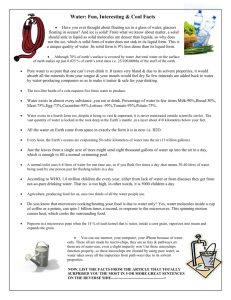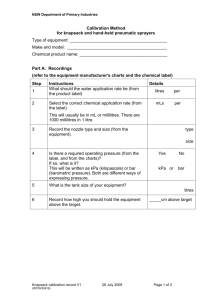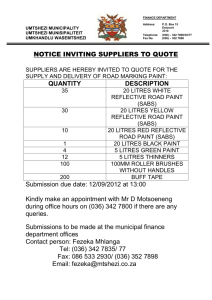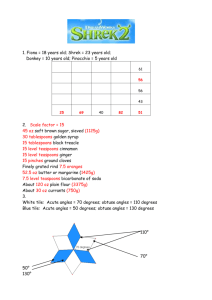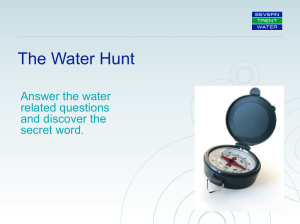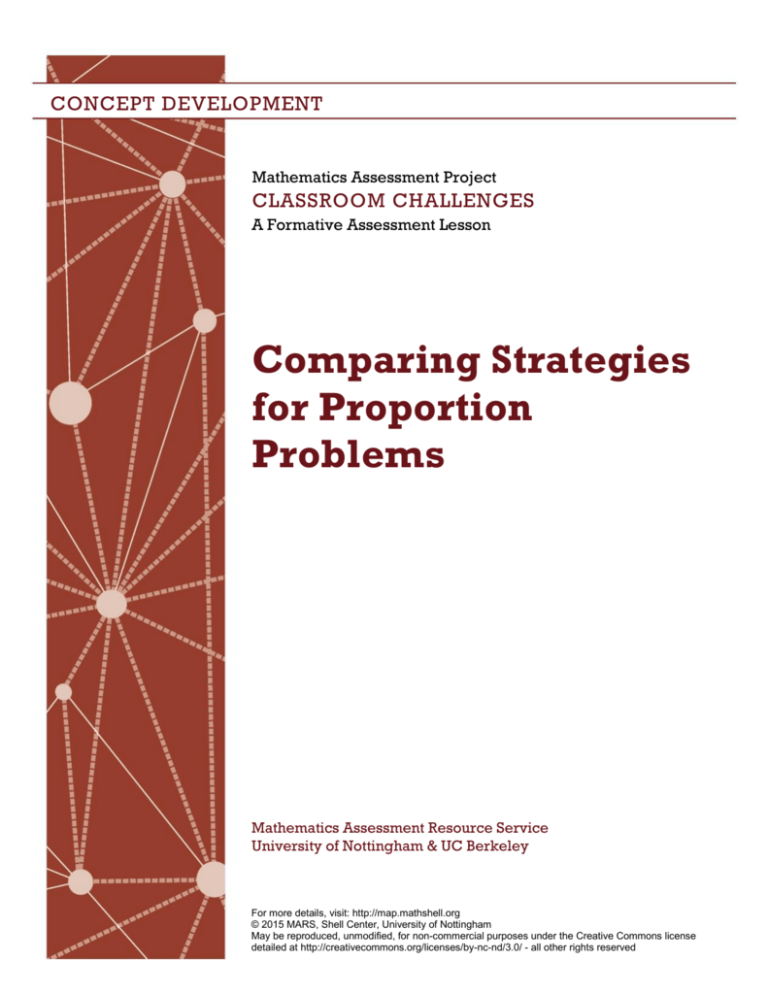
CONCEPT DEVELOPMENT
Mathematics Assessment Project
CLASSROOM CHALLENGES
A Formative Assessment Lesson
Comparing Strategies
for Proportion
Problems
Mathematics Assessment Resource Service
University of Nottingham & UC Berkeley
For more details, visit: http://map.mathshell.org
© 2015 MARS, Shell Center, University of Nottingham
May be reproduced, unmodified, for non-commercial purposes under the Creative Commons license
detailed at http://creativecommons.org/licenses/by-nc-nd/3.0/ - all other rights reserved
Comparing Strategies for Proportion Problems
MATHEMATICAL GOALS
This lesson unit is intended to help you assess whether students recognize relationships of direct
proportion and how well they solve problems that involve proportional reasoning. In particular, it is
intended to help you identify those students who:
•
Use inappropriate additive strategies in scaling problems, which have a multiplicative structure.
•
Rely on piecemeal and inefficient strategies such as doubling, halving, and decomposition and
have not developed a single multiplier strategy for solving proportionality problems.
•
See multiplication as making numbers bigger and division as making numbers smaller.
COMMON CORE STATE STANDARDS
This lesson relates to the following Standards for Mathematical Content in the Common Core State
Standards for Mathematics:
7.RP: Analyze proportional relationships and use them to solve real-world and mathematical
problems.
This lesson also relates to the following Standards for Mathematical Practice in the Common Core
State Standards for Mathematics, with a particular emphasis on Practices 1, 2, 3, 4, and 8:
1.
2.
3.
4.
6.
7.
8.
Make sense of problems and persevere in solving them.
Reason abstractly and quantitatively.
Construct viable arguments and critique the reasoning of others.
Model with mathematics.
Attend to precision.
Look for and make use of structure.
Look for and express regularity in repeated reasoning.
INTRODUCTION
This lesson unit is structured in the following way:
•
Before the lesson, students work individually on a task designed to reveal their current levels of
understanding and difficulties. You review their work, writing questions to help them to improve.
•
During the lesson, students first work in pairs or threes on the same task. Then working in the
same small groups, they analyze work produced by other students on the task.
•
In a whole-class discussion, students compare and evaluate the methods they have seen and used.
•
Finally, students review their initial, individual response, using their learning to complete a new
similar task.
MATERIALS REQUIRED
•
Each individual student will need a mini-whiteboard, pen, and eraser, a calculator and a copy of
the tasks A Sense of Scale and A Sense of Scale (revisited).
•
Each small group of students will need a large sheet of poster paper and a copy of each of the
Sample Responses to Discuss.
TIME NEEDED
15 minutes before the lesson, a 60-minute lesson, and 15 minutes in a follow-up lesson. These timings
are approximate. Exact timings will depend on the needs of your students.
Teacher guide
Comparing Strategies for Proportion Problems
T-1
BEFORE THE LESSON
Assessment task: A Sense of Scale (15 minutes)
Have the students complete this task in class or
A Sense of Scale
for homework a few days before the formative
1.
Here
is
a
recipe
for
making
4
pancakes:
assessment lesson. This will give you a chance
6 tablespoons flour
to assess the work and to find out the kinds of
! pint milk
! pint water
difficulties students have with it. You should
1 pinch salt
1 egg
then be able to target your help more
You want to make 10 pancakes.
effectively in the subsequent lesson.
a. How much flour do you need?
Give each student a copy of the A Sense of
Scale task and a calculator.
b. How much milk do you need?
Read through the questions and try to
answer them as carefully as you can.
Explain how you figured out your answers
and record all your calculations.
It is important that, as far as possible, students
are allowed to answer the questions without
your assistance.
2. Calculate the prices of the paint cans.
The prices are proportional to the amount of paint in the can.
£ .....
""
£ .....
£ 15
""
£ .....
£ ..... $15
£ .....
£ .....
!!!!!!!!!
£ .....
£ .....
£ .....£ ..... £ .....£ .....
Explain to students that they should not be
concerned if they cannot complete everything
in the task. In the next lesson they will work on
this material, which should help them to make
progress.
£ 15
£ 15£ 15
0.6
0.75
litres
litres
0.6 0.60.750.75
litres
1
1 1
litres 0.75 liters
litres
0.6
liters
1 litre
liter
litres
litre litre
0.6
0.75
0.6 litres
0.75 litres 1
0.75 litres
litres litres0.6
litre
litres
Student
3. The Materials
photograph
£ 15 ""
£ 15
£ .....
£ .....
£ .....£ .....
2.5
2.5 2.5
litres
litres
2.5
liters
litres
1
litre 1
litre
"".
£ .....
£ .....
£ ......
$76.50£ ......
£ ......
£ ......
£ ......
£ ......
4.54
litres
litres
4.544.54
litres
(1 gallon)
(1 gallon)
liters
gallon)
2.5(1 4.54
2.5
litres litres2.5
litres
......
4.54
litres
4.54 litres
4.54 litres
(1 gallon)
(1 gallon)
(1 gallon)
is enlarged to make a Developing
poster. a Sense of Scale
S-1
© 2014 MARS, Shell Center, University of Nottingham
The photograph is 10cm wide and 16cm high.
Students who sit together often produce similar
answers and then when they come to compare
their work, they have little to discuss. For this
reason, we suggest that when students do the
task individually, you ask them to move to
different seats. Then at the beginning of the
next lesson, allow them to return to their usual
seats. Experience has shown that this produces
more profitable discussions.
Photograph
Poster
16 cm
?
10 cm
25 cm
a. The poster is 25cm wide.
How high is the poster?
Assessing students’ responses
Carefully read through students’ responses to
b. The building on the poster is 30cm tall.
Is it possible to figure out how tall the building is on the photograph?
the task. Make notes about what the work
If you think it is possible, show how. If you think it is not, explain why.
shows you about their current levels of
understanding and different solution strategies. This will forewarn you of issues that may arise during
the lesson.
We suggest that you do not score students’ work. The research shows that this will be
counterproductive as it will encourage students to compare scores and will distract their attention
from what they can do to improve their mathematics.
Student Materials
Developing a Sense of Scale
© 2014 MARS, Shell Center, University of Nottingham
Instead, help students to make progress by summarizing their difficulties as a series of questions.
Some suggestions for these are given in the Common issues table on page T-4.
Teacher guide
Comparing Strategies for Proportion Problems
S-2
T-2
We suggest you make a list of your own questions, based on your students’ work. We recommend
you either:
•
write one or two questions on each student’s work, or
give each student a printed version of your list of questions and highlight the questions for each
individual student.
If you do not have time to do this, you could select a few questions that will be of help to the majority
of students and write these on the board when you return the work to the students at the beginning of
the lesson.
•
Teacher guide
Comparing Strategies for Proportion Problems
T-3
Common issues:
Suggested questions and prompts:
Uses mental or jotted strategies
For example: The student has (correctly or
incorrectly) calculated solutions but written little.
Uses informal strategies
For example: The student answers every question
using a different calculation method.
Or: The student has used doubling and halving
with addition. Elion and Faith’s Sample
Responses to Discuss use these types of strategies.
Identifies the problem structure as additive
rather than multiplicative (Q1, Q3)
For example: The student adds the same number
each time, rather than finding the scale factor and
multiplying by the same amount each time.
Gavin’s solution, in the Sample Responses to
Discuss, is an example of this misconception.
Chooses inappropriate arithmetic operations
For example: The student chooses to divide rather
than multiply, perhaps thinking division makes
things smaller, multiplication makes them bigger.
Uses unit rate method
For example: The student calculates the number
of ounces of flour per pancake and then multiplies
by the total number of pancakes.
Uses method of cross multiplying proportions
For example: The student specifies the
proportional relationship between known and
unknown quantities and cross-multiplies.
15 = x
1 = x
2.5 (correct) or 15 2.5 (incorrect) (Q4).
E.g. 1
€
• Can you explain in more detail how you
figured out your solution?
• Help your reader to understand your solution.
• Can you think of a method that could be used
for any quantity, e.g. 13 pancakes, a width of
22.5 cm?
• Can you find a really efficient way of solving
the problem?
• (Q1) How much flour is needed for one
pancake? How can you use this in your
solution?
• (Q3) Enlargement changes the size but not the
shape of the rectangle. Draw the two
rectangles from your solution. Are they
similar? What is the effect of enlargement on
side length?
• Write some sentences to explain how to
calculate the answer.
• What size of answer do you expect? Why? Use
a calculator to check your estimate.
• What is the scale factor? Can you use this
number in your other calculations?
• (Q2) Which of these numbers are quantities of
paint? Which are prices? What is the
relationship between the two quantities of
paint? What is the relationship between this
price and that quantity of paint?
• Can you explain why your method works?
• Can you find a different way of calculating
this answer?
€ of the poster accurately (Q3)
Draws the outline
• How did you figure out the height of the
poster?
• How does drawing a poster accurately help?
Answers all problems correctly and efficiently
• Find at least two different, correct methods for
solving these problems. Which do you prefer?
Why?
• Think about the three problems you have
answered. Write down how they are different
and how they are the same.
Teacher guide
Comparing Strategies for Proportion Problems
T-4
SUGGESTED LESSON OUTLINE
Improving individual solutions (5 minutes)
Give each student his or her script and a mini-whiteboard, pen, and eraser. Remind students of their
work on A Sense of Scale.
Recall the problems you were working on in the last lesson. Today we are going to work together
to improve that work.
First I have some questions about your individual solutions. I would like you to read through the
questions I have written and spend a few minutes on your own improving your work. Use your
mini-whiteboards.
If you have not added questions to students’ work, display your list of questions on the board now.
Collaborative activity: producing small-group solutions (15 minutes)
Organize students into groups of two or three.
Give each group a large sheet of paper for making a poster to show their solutions.
Your task now is to come up with a really good, efficient method for solving each problem.
Work together on one problem at a time.
Take turns to explain your method to others in the group. Listen carefully to each other. Ask
questions if you don't understand or agree.
If you discuss more than one method, together decide which method is best. Then, on the poster,
write a complete solution using that method, explaining your reasoning.
Before you move on to the next problem, make sure every person in your group understands and
can explain the group’s method.
Slide P-1 of the projector resource summarizes these instructions.
While students work in small groups you have two tasks: to note their different approaches to the task
and to support student reasoning:
Note different approaches to the task
Listen and watch students carefully. Note different approaches to the task and any incorrect solutions.
You will be able to use this information in the whole-class discussion.
•
Do students incorrectly treat the problems as having an additive structure? For example, the
student might argue that the number of pancakes increases by 6, so the number of tablespoons of
flour will also increase by 6.
•
Do students use doubling and halving with addition?
•
Do students calculate unit rates? If so, which rate do they use (e.g. ounces of flour per pancake, or
pancakes per ounce of flour)?
•
Do any students use cross-multiplication with a proportion involving three known quantities and
one missing quantity? If so, do they correctly organize the quantities to show their interrelationships correctly? Can they explain why the method works?
•
Do any students use multiplication by a scale factor? Are they successful? Can they explain why
the method works?
•
Are students checking that their answers are correct and that their explanations make sense?
Teacher guide
Comparing Strategies for Proportion Problems
T-5
Support student reasoning
Try not to make suggestions that move students towards a particular approach to the task. Instead,
ask questions that help students to clarify their thinking. The questions in the Common issues table
may be helpful.
To support students really struggling with a particular part of the task, you might hand out one or two
of the Sample Responses to Discuss. If the whole-class is struggling with the same issue you could
write a couple of relevant questions on the board, or hold a short whole-class discussion.
You may find students use relatively inefficient methods. For example, they may prefer doubling and
halving with addition. This works well when dealing with fairly ‘simple’ numbers such as integers,
but is hard to generalize to more ‘difficult’ numbers such as those with three decimal places.
Ask questions to develop students’ thinking about their methods:
Why do you prefer this method?
Show me how to calculate the amount of flour needed for one pancake. How can you use this
information to solve the problem?
Does your method work for calculating all the amounts and quantities? If not, can you think of
one?
Can you think of a method to calculate any amounts including ‘difficult’ numbers such as 1.73?
How do you calculate a scale factor? How can you use the scale factor to solve the problem?
What is the unit rate? How can you use this to solve the problem?
In which problems do you prefer using scale factors/unit rates? Why?
Students might use an efficient strategy such as multiplying by a scale factor or setting up a
proportion and cross-multiplying with little understanding of why their method works.
Why does your method work?
This number you’re multiplying by - the scale factor - where does that come from? How does it
connect these quantities/amounts?
Check that each member of the group understands and can explain each answer. If you find a student
is struggling to respond to your questions, return to the group a few minutes later and check they have
worked together on understanding.
If any students finish early, ask them to find a different way of solving one of the problems and to
compare the efficiency of their different methods.
You may at this point want to hold a brief whole-class discussion. Focus on the variety of methods
students used, any interesting ways of working and incorrect methods you have noticed. Encourage
students to compare and evaluate different methods and to think about which method can be applied
to any amount or quantity. Slides P-2 to P-4 of the projector resource may be helpful with this
discussion.
Collaborative analysis of Sample Responses to Discuss (20 minutes)
Once the students have had time to tackle all the questions together, give each group a copy of all
three Sample Responses to Discuss. This task gives students an opportunity to evaluate a variety of
approaches to the scaling problems.
Here are some Sample Responses to the problems you’ve been working on, written by students in
another class. I want you to review their work.
Teacher guide
Comparing Strategies for Proportion Problems
T-6
Choose one sample solution to work on together. Read through the work carefully. Note any
errors in the student’s solution and answer the questions on the sheet. Try to focus on reviewing
the math issues, not effort or how neatly the work is written.
Make sure every person in your group understands and can explain your answers before moving
on to the next sample solution.
During the small-group work, support the students as before. Note the explanations students struggle
most to understand. Note similarities and differences between the Sample Responses and those the
students took in the small-group work.
Whole-class discussion: comparing different approaches (20 minutes)
Focus the whole-class discussion on developing the key idea of this lesson: these problems all share
the same structure and could all be solved in the same way.
Use your knowledge of the students’ individual and group work to call on a wide range of students
for contributions. You may want to draw on the questions in the Common issues table to support your
own questioning.
To support this discussion there are Slides of each of the Sample Responses to Discuss (P-5 to P-7).
Although these problems all look very different, they have something in common.
What do you think is the same about all these problems? [They involve working with a
proportional relationship between two quantities and can all be solved using the same methods.]
How has Eilon figured out the solution?
What mistakes has Faith made?
Did any of you use that method? A different method?
Which method did you use for this problem? Why did you prefer that method?
Did anyone use a method that can be applied to every single problem?
The following analysis of the Sample Responses may be helpful in supporting your questioning:
Eilon first attempts to use ratios, but abandons this
method for an informal additive strategy. He has
made a common error in his fractions calculation,
adding the numerators to each other, then adding
the denominators to each other, rather than finding
a common denominator first and adding the
numerators.
What method do you think Eilon was trying to
use with a proportion?
Why do you think Eilon abandoned the work he
started with proportion?
Did any of you use that method? Can you show
us how to complete the work correctly?
What does 104 represent? [The scale factor – the
relationship between the number of pancakes
and the scaled number of pancakes.]
Teacher guide
Comparing Strategies for Proportion Problems
T-7
Developing a Sense of Scale
Student Materials
Alpha Version January 2012
Sample Responses to Discuss to Discuss: Faith
Faith uses a different strategy for each paint can.
She uses the informal additive strategy correctly for
the ‘easier’ amounts, 0.75 liters and 2.5 liters. She
then tries, unsuccessfully, to use this same method
to calculate the price for 4.54 liters of paint. She
then changes strategy and successfully uses a
multiplicative strategy to figure out the price.
To calculate the price for 0.6 liters of paint, Faith
has chosen to divide rather than multiply. This may
be a symptom of the misconception that division
always makes numbers smaller and multiplyingExplain why Faith used different methods for different amounts of paint.
always makes numbers larger. As the can is
small, Faith assumes the answer is in cents.
0. 6 liters
0.75 liters
1 liter
2.5 liters
4.54 liters
mistakes has Faith made?
To calculate the amount of paint in the largest can,WhatFaith
correctly divides $76.50 by 15.
Faith could improve her answer by writing sums of money correctly, with two decimal places not one.
She has also incorrectly used the equal sign.
Why has Faith deleted some of her work?
Can you think of one method Faith could use to figure out all the prices?
Why does Faith divide 76.50 by 15?
Is there one method that Faith could use for every single problem? [She could multiply each
quantity by the same scale factor.]
Developing a Sense of Scale
Student Materials
Alpha Version January 2012
Sample Responses to Discuss to Discuss: Gavin
© 2011 MARS University of Nottingham
S-4
Gavin incorrectly uses an additive strategy. He is
not considering proportion, but using the difference
between known lengths to calculate unknown ones.
This is a common error in ratio problems.
What is the scale factor of enlargement?
How could Gavin use the scale factor to
calculate the lengths?
Students may find it difficult to solve the second,
reverse question. Some students are not convinced
that lengths within pictures scale by the same
factor.
Do you think the pagoda scales by the same
factor as the side lengths?
What Math did Gavin do well?
Suppose I take the height of the pagoda in the
What mistakes has Gavin made?
poster and multiply it by the scale factor. Is that
how you solve this problem? What’s my
deliberate error?
Can you think a better method Gavin could use?
© 2011 MARS University of Nottingham
Teacher guide
Comparing Strategies for Proportion Problems
S-5
T-8
Follow-up lesson: A Sense of Scale (revisited) (15 minutes)
Give the students back their original scripts from the assessment task A Sense of Scale, along with a
copy of the task A Sense of Scale (revisited).
If you did not add questions to individual pieces of work, write your list of questions on the board
again now.
Look at your original response and read through my questions. Answer these questions and
revise your response.
Now, using what you have learned, try to answer the questions on the new task, A Sense of Scale
(revisited).
Explain how you figure out your answers and record all your calculations.
Some teachers give this for homework.
Teacher guide
Comparing Strategies for Proportion Problems
T-9
SOLUTIONS
A Sense of Scale
These questions do not require a succinct or formal method and may elicit effective but inefficient use
of repeated addition for multiplication or strategies involving doubling and halving with addition.
Some methods are described in Question 1. They could be applied to the other two problems.
1. Method A
1
of a pint of milk.
4
1
So for 2 pancakes, you need 3 tablespoons of flour and pints of milk.
8
So for 10 pancakes, you need 3 + 3 + 3 + 3€+ 3 =15 tablespoons of flour
For 4 pancakes you need 6 tablespoons of flour and
and
1
1
1
1
1
5
+
+
+
+
=
of a pint €
of milk.
8
8
8
8
8
8
Method B
€
The number of pancakes increases from 4 to 10. This gives a scale factor of
10
= 2.5.
4
The quantity of flour for ten pancakes: 2.5 × 6 = 15 tablespoons.
The quantity of milk for ten pancakes: 2.5 × 0.25 = 0.625 or
5
€
pints.
8
Method C
The quantity of flour per pancake is 6 ÷ 4 = 1.5 tablespoons.
€
1
1
The quantity of milk per pancake is
÷ 4 =
pints.
4
16
For 10 pancakes, you will need 10 × 1.5 = 15 tablespoons of flour and
Method D
€
1
5
× 10 = pints of milk.
16
8
The ratio of pancakes to flour: 4 : 6 . This ratio stays constant as you change the number of pancakes.
€
Scaling the number of pancakes: 10 = 2.5× 4 .
The amount of flour is to be scaled by the same factor to keep the ratio constant: x = 2.5× 6 = 15 .
€
For 10 pancakes you need 15 tablespoons of flour.
€
Using the same form of reasoning, you need 0.625 = 2.5× 0.25 pints of milk for ten pancakes.
€
2. Again, students may use a range of strategies to solve this problem correctly.
Using the unit rate of $15 per liter is a powerful,
economical, and simple strategy:
€
1 liter costs $15.
0.6 liters costs $15 × 0.6 = $9
0.75 liters costs $15 × 0.75 = $11.25.
2.5 liters costs $15 × 2.5 = $37.50.
4.54 liters costs $15 × 4.54 = $68.10.
Teacher guide
Comparing Strategies for Proportion Problems
T-10
Students may find it more difficult to reverse the unit rate to find the volume of paint. The can costing
$76.50 contains 76.50 ÷ 15 = 5.1 liters.
3. Again students may use a range of methods, including doubling and halving with addition.
Using the unit rate is an efficient strategy.
Scale factor: 25 ÷ 10 = 2.5.
Height of poster: 16 × 2.5 = 40 cm.
Height of building in the photograph is 30 ÷ 2.5 = 12 cm.
A Sense of Scale (revisited)
The questions in this task are structurally similar to those in the first task. Only the numbers have
changed. As with the first assessment task, what is most important here are the methods students
choose to use and whether they can implement those methods effectively.
Compare students’ responses on the two versions of the task.
Have any students changed the methods they use?
Have any improved in use of chosen methods?
We provide correct numerical answers for convenience.
1. The scale factor is
28
= 3.5 .
8
a. 14 cups of flour.
b. 1 3 cups
€ of milk.
4
2. The unit rate is $12 per liter.
€
0.25 liters cost $3.00.
0.7 liters cost $8.40.
2.5 liters cost $30.00.
3.52 liters cost $42.24.
A can that costs $57.60 contains 4.8 liters of paint.
3. The scale factor is 4.5
a. The height of the poster is 54 cm.
b. The height of building in the photograph is 8 cm.
Teacher guide
Comparing Strategies for Proportion Problems
T-11
A Sense of Scale
1. Here is a recipe for making 4 pancakes:
6 tablespoons flour
¼ pint milk
¼ pint water
1 pinch salt
1 egg
You want to make 10 pancakes.
a. How much flour do you need?
b. How much milk do you need?
2. Calculate the prices of the paint cans.
The prices are proportional to the amount of paint in the can.
£ .....
……
£ .....
£ 15
……
£ .....
£ ..... $15
£ .....
£ .....
!!!!!!!!!
£ .....
£ .....
£ .....£ ..... £ .....£ .....
£ 15
£ 15£ 15
0.6
0.75 litres
0.6 0.60.750.75
litreslitres
1
1 1
litres 0.75 liters
litre
litres
0.6
liters
1 liter
litres
litre litre
0.6
0.75
0.6 litres
0.75 litres 1
0.75 litres
litres litres0.6
litre
litres
Student materials
£ 15……
£ 15
£ .....
£ .....£ .....
2.5
2.5 2.5
litres
litres
2.5
liters
litres
1
litre 1
litre
£ .....
…….
£ .....
£ .....
£ ......
$76.50£ ......
£ ......
£ ......
£ ......
£ ......
4.54
litres
litres
4.544.54
litres
(1 liters
gallon)
(1 gallon)
(1 4.54
gallon)
2.5
2.5
litres litres2.5
litres
Comparing Strategies for Proportion Problems
© 2015 MARS, Shell Center, University of Nottingham
......
4.54
litres
4.54 litres
4.54 litres
(1 gallon)
(1 gallon)
(1 gallon)
S-1
3. The photograph is enlarged to make a poster.
The photograph is 10cm wide and 16cm high.
Photograph
Poster
16 cm
?
10 cm
25 cm
a. The poster is 25cm wide.
How high is the poster?
b. The building on the poster is 30cm tall.
Is it possible to figure out how tall the building is on the photograph?
If you think it is possible, show how. If you think it is not, explain why.
Student materials
Comparing Strategies for Proportion Problems
© 2015 MARS, Shell Center, University of Nottingham
S-2
Sample Responses to Discuss: Eilon
Explain Eilon’s method.
What mistakes has Eilon made?
At first Eilon tries to use a proportion to solve the problem. Show how you can use a proportion to
calculate the amount of flour correctly.
correctly
Student materials
Comparing Strategies for Proportion Problems
© 2015 MARS, Shell Center, University of Nottingham
S-3
Sample Responses to Discuss: Faith
0. 6 liters
0.75 liters
1 liter
2.5 liters
4.54 liters
Why do you think Faith used lots of different methods?
What mistakes has Faith made?
Find a method Faith could use to figure out answers to all the parts of the question.
Student materials
Comparing Strategies for Proportion Problems
© 2015 MARS, Shell Center, University of Nottingham
S-4
Sample Responses to Discuss: Gavin
What mistakes has Gavin made?
Can you think a better method Gavin could use?
Student materials
Comparing Strategies for Proportion Problems
© 2015 MARS, Shell Center, University of Nottingham
S-5
A Sense of Scale (revisited)
1. Here is a recipe for making 8 doughnuts:
4 cups of flour
1/2 cup of milk
3/4 cup of sugar
2 eggs
2 sticks of butter
One tablespoon of yeast
You want to make 28 doughnuts.
a. How much flour do you need?
b. How much milk do you need?
2. Calculate the prices of the paint cans.
The prices are proportional to the amount of paint in the can.
……
£ .....
……
£ .....
£ .....
£ .....
!!!!!!!!!
£ .....
£ .....
£ .....£ ..... £ .....£ .....
$12
£ 15
£ .....
£ .....
£ 15
£ 15£ 15
0.6 0.75
0.75
litres
litres
1 1
0.6 0.6
0.75 litres
1
litres
litre
litres
litre
litres
litre
0.6
0.75 litres
1
0.6 0.7 liters
0.75 litres
0.25 liters
1 liter
0.6
0.75 litres
litres
litres
litres
Student materials
litre
……
£ 15
£ 15
£ ..... ……
£ .....
£ .....
£ .....
£ .....£ .....
£ ......
£ ......
£ ......
2.5
2.5 2.5
litres
litres
litres
4.54
litres
litres
4.544.54
litres
(1 gallon)
(1 gallon)
(1 gallon)
1 2.5 liters 2.5 3.52
2.5
liters
litres litres2.5
litre 1
litre
litres
Comparing Strategies for Proportion Problems
© 2015 MARS, Shell Center, University of Nottingham
$57.60
£ ......
£ ......
£ ......
4.54
litres
4.54 litres
......
4.54 litres
(1 gallon)
(1 gallon)
(1 gallon)
S-6
3.
a. The poster is 72 cm wide.
How high is the poster?
b. The building on the poster is 36 cm tall.
Is it possible to figure out how tall the building is on the photograph?
If you think it is possible, show how. If you think it is not, explain why.
Student materials
Comparing Strategies for Proportion Problems
© 2015 MARS, Shell Center, University of Nottingham
S-7
Working Together
Find a good, efficient method for solving each problem.
Work together on one problem at a time.
• Take turns to explain your method to your group.
– Listen carefully.
– Ask questions if you do not understand or agree.
• If you discuss more than one method, together decide which
way you all think is best.
• Write your solution on the poster and explain it.
Before you move on to the next problem,
make sure that everyone in your group can explain the
group’s method.
Projector Resources
Comparing Strategies for Proportion Problems
P-1
Developing a Sense of Scale
Student Materials
A Sense of Scale
Recipe
1. Here is a recipe for making 4 pancakes:
6 tablespoons flour
! pint milk
! pint water
1 pinch salt
1 egg
You want to make 10 pancakes.
a. How
flour
do you need?
You
wantmuch
to make
10 pancakes.
a. How much flour do you need?
b. How much milk do you need?
Projector Resources
Comparing Strategies for Proportion Problems
b. How much milk do you need?
P-2
Paint Prices
2. Calculate the prices of the paint cans.
The prices are proportional to the amount of paint in the can.
£ .....
……
£ .....
£ 15
……
$15
£ .....
£ .....
£ .....
£ .....
!!!!!!!!!
£ ..... £ .....
£ .....
£
.....
£ .....
£ .....
£ 15
£ 15£ 15
0.6 0.75
0.75
litres
litres
1 1
0.6 0.6
0.75
litres
1
litre
0.6litres
literslitres 0.75 liters 1 liter
0.6 litres0.75 litres litrelitre 1
£ .....
£ .....
£ .....£ .....
0.6
0.75 litres
0.6
0.75 litres
litres litres
litre
011 MARS University oflitres
Nottingham
Projector Resources
£ 15……
£ 15
2.5
2.5 2.5
litres
2.5
liters
litres
litres
1
litre 1
litre
S-1
…….
£ .....
£ .....
£ ......
$76.50£ ......
£ ......
£ ......
£ ......
£ ......
4.54
litres
litres
4.544.54
litres
(1
gallon)
4.54
liters
(1 gallon)
2.5(1 gallon)
2.5
litres litres2.5
litres
Comparing Strategies for Proportion Problems
......
4.54 litres
4.54 litres
4.54 litre
(1 gallon)
(1 gallon)
(1 gallo
P-3
Enlarging a Poster
Developing a Sense of Scale
Student Materials
Alpha Version Ja
3. The photograph is enlarged to make a poster.
3. TheThe
photograph
toand
make
a poster.
photographisisenlarged
10cm wide
16cm
high.
The photograph is 10cm wide and 16cm high.
Photograph
Poster
16 cm
?
10 cm
25 cm
a. The
poster
isis25
cm wide,
a. The
poster
25cm
wide. how high is the poster?
high ison
thethe
poster?
b. TheHow
building
poster is 30 cm tall.
Is it possible to figure out how tall the building is on the photograph?
If you think it is possible, show how. If you think it is not, explain why.
Projector Resources
Comparing Strategies for Proportion Problems
b. The building on the poster is 30cm tall.
P-4
eveloping a Sense of Scale
Student Materials
Alpha Version January 2012
Sample
Responses
to Discuss:
Eilon
Sample Responses
to Discuss
to Discuss: Eilon
Projector Resources
xplain Eilon's method.
Comparing Strategies for Proportion Problems
P-5
Developing a Sense of Scale
Student Materials
Alpha Version January 2012
Sample
to Discuss:
Faith
SampleResponses
Responses to Discuss
to Discuss: Faith
0. 6 liters
Projector Resources
0.75 liters
1 liter
2.5 liters
4.54 liters
Comparing Strategies for Proportion Problems
Explain why Faith used different methods for different amounts of paint.
P-6
Sample Responses
to
Discuss:
Gavin
Sample Responses to Discuss to Discuss: Gavin
Developing a Sense of Scale
Projector Resources
Student Materials
Alpha Version January 2012
Comparing Strategies for Proportion Problems
What Math did Gavin do well?
P-7
Mathematics Assessment Project
Classroom Challenges
These materials were designed and developed by the
Shell Center Team at the Centre for Research in Mathematical Education
University of Nottingham, England:
Malcolm Swan,
Nichola Clarke, Clare Dawson, Sheila Evans, Colin Foster, and Marie Joubert
with
Hugh Burkhardt, Rita Crust, Andy Noyes, and Daniel Pead
We are grateful to the many teachers and students, in the UK and the US,
who took part in the classroom trials that played a critical role in developing these materials
The classroom observation teams in the US were led by
David Foster, Mary Bouck, and Diane Schaefer
This project was conceived and directed for
The Mathematics Assessment Resource Service (MARS) by
Alan Schoenfeld at the University of California, Berkeley, and
Hugh Burkhardt, Daniel Pead, and Malcolm Swan at the University of Nottingham
Thanks also to Mat Crosier, Anne Floyde, Michael Galan, Judith Mills, Nick Orchard, and Alvaro
Villanueva who contributed to the design and production of these materials
This development would not have been possible without the support of
Bill & Melinda Gates Foundation
We are particularly grateful to
Carina Wong, Melissa Chabran, and Jamie McKee
The full collection of Mathematics Assessment Project materials is available from
http://map.mathshell.org
© 2015 MARS, Shell Center, University of Nottingham
This material may be reproduced and distributed, without modification, for non-commercial purposes,
under the Creative Commons License detailed at http://creativecommons.org/licenses/by-nc-nd/3.0/
All other rights reserved.
Please contact map.info@mathshell.org if this license does not meet your needs.


